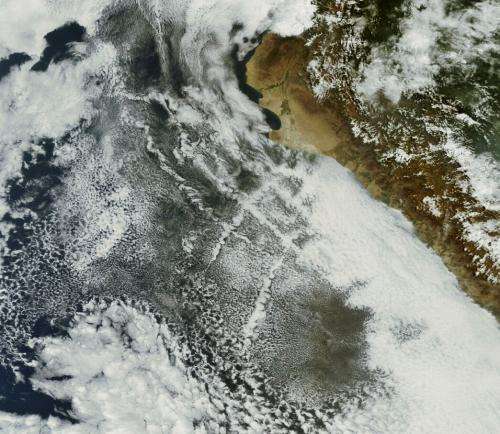When clouds hang out with pollution: Clean-sky clouds more susceptible to pollution's pressure, research finds

Clouds are influenced by the company they keep. Scientists at Pacific Northwest National Laboratory and the National Center for Atmospheric Research (NCAR) found that ocean-hugging clouds in clean regions are more affected by pollution than clouds in an already polluted setting. Cloud trails from ships, called "ship tracks," are a small-scale example of this effect. Pollution exhaust from ships forms streaks of clouds that are brighter than neighboring clouds. The researchers learned that the amount of pollution already in a region strongly moderates any effect on cloud characteristics from additional pollution. Their study was published in the journal Atmospheric Chemistry and Physics.
To understand how the climate system operates, scientists use a computer model to replicate climate features like incoming sunlight and clouds. Cloud types called marine stratocumulus that hover low and thin over the ocean are difficult to correctly model. Yet, because they are so bright and reflective, these are the very clouds that have a large influence on the heating and cooling balance of the atmosphere. The dark blue ocean is an effective heat storage tank, filling up from the sun's energy. When clouds reflect or block the sun's light, that reduces the amount of heat stored. Scientists in this study are working to better represent the reflective marine stratocumulus cloud characteristics in climate models. Ultimately, this new understanding will improve future climate projections.
In a study led by climate scientist Dr. Qing Yang, the PNNL team used the Weather Research and Forecasting (WRF) model to investigate the importance of different kinds of particles in the atmosphere and their effect on clouds. WRF is a regional climate model that takes a detailed look at cloud and particle interaction. The team studied the impacts of relative changes in human-induced pollution particles on the simulated cloud characteristics, such as how much water is in the clouds and how reflective they may be to sunlight. They performed similar comparisons for differences induced by natural particle sources, such as sea salt. They found that additional pollution over pristine regions of the ocean has a larger effect on the clouds than in already polluted regions. Essentially, adding the same amount of pollution to clean marine air makes clouds brighter and hold more water than when adding the same amount of extra pollution to dirty regions.
This study used a regional, small-scale atmospheric model with a grid spacing that represents what is expected in climate models in about a decade. As they prepare for the next generation of climate models, scientists will need to develop more powerful handling of the physical processes that occur within the atmosphere. Current global climate models do not have the computational horsepower to represent as much detail as was used in this study. So, the question is how well a simplified representation of the processes in this study presents reality in climate models. Scientists will continue investigating how to represent small-scale processes like clouds in the larger-scale, less detailed global models.
More information: Yang Q, WI Gustafson, JD Fast, H Wang, RC Easter, M Wang, SJ Ghan, LK Berg, LR Leung, and H Morrison. 2012. "Impact of Natural and Anthropogenic Aerosols on Stratocumulus and Precipitation in the Southeast Pacific: A Regional Modeling Study Using WRF-Chem." Atmospheric Chemistry and Physics 12:8777-8796. DOI:10.5194/acp-12-8777-2012.
Journal information: Atmospheric Chemistry and Physics
Provided by Pacific Northwest National Laboratory



















